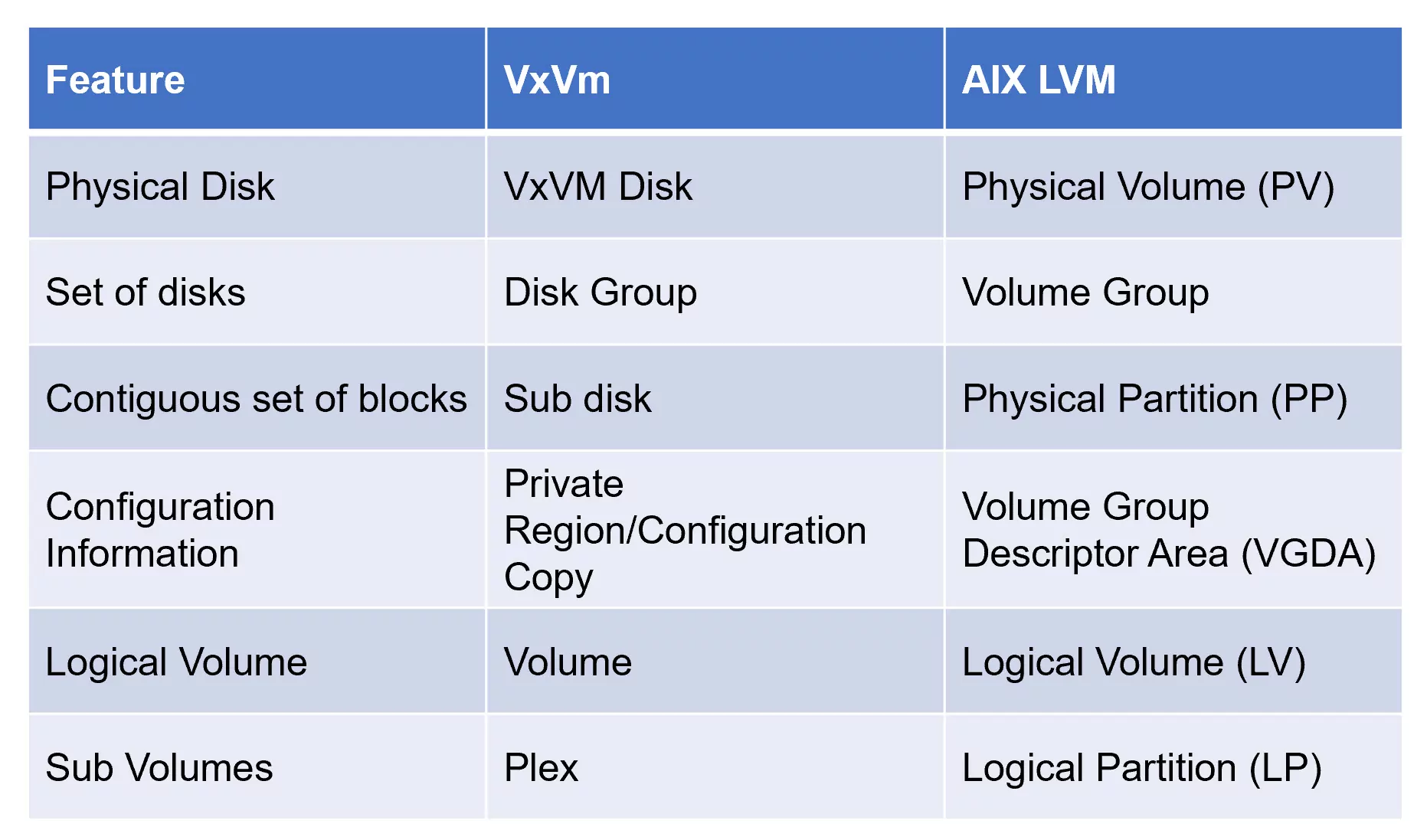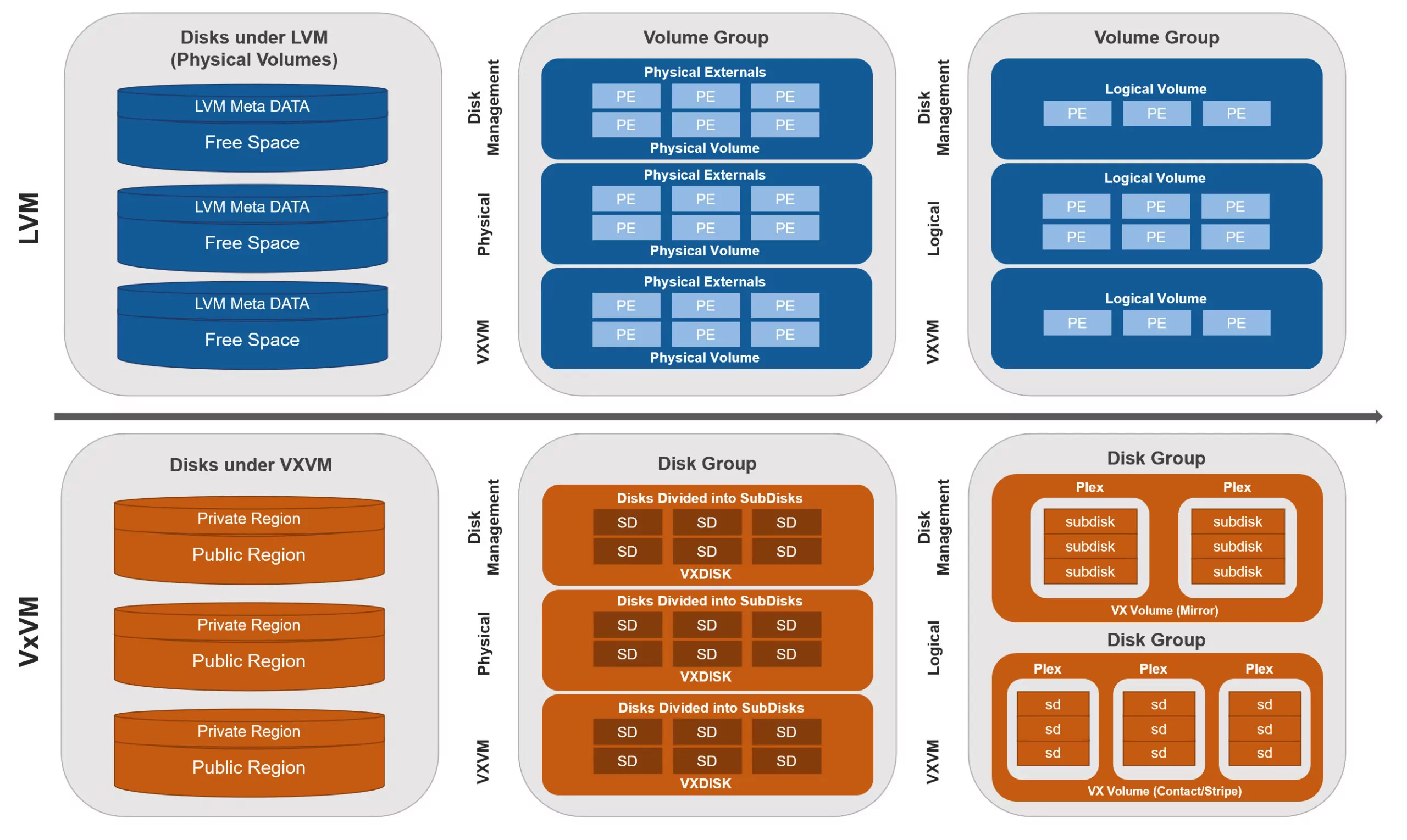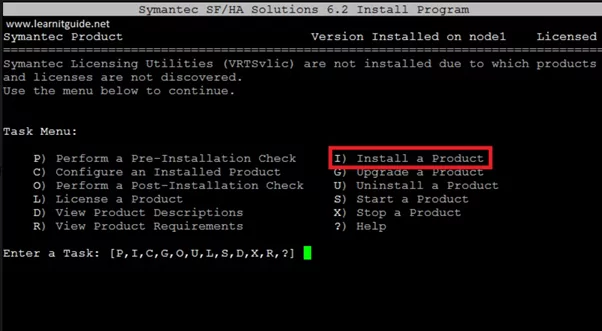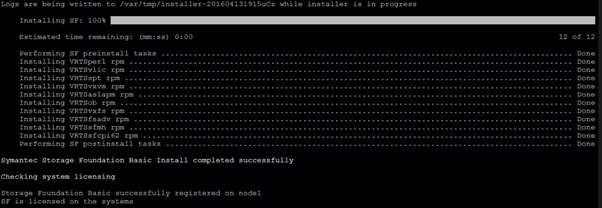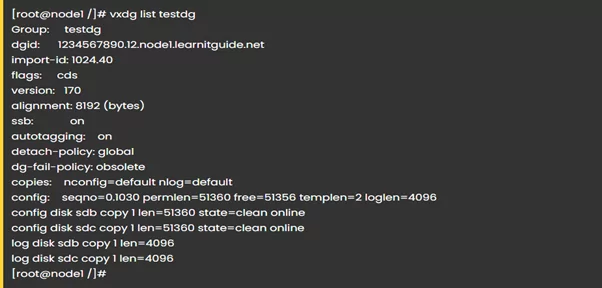Symantec’s Veritas Volume Manager (VxVM) is a storage management subsystem that allows you to manage physical disks as logical devices called volumes. This blog will outline and dive deeper into the components of a Veritas Volume Manager.
Why VxVM?
We have a volume manager called “LVM,” which comes with OS installation by default in the Linux operating system.
Logical volumes are an alternate method of partitioning hard drive space. The capability has been built into the Linux kernel since 1999.
Linux and Partitions
Windows and OS X assume that the hard drive is a single monolithic partition. Linux assumes that a hard drive will be partitioned as part of the basic operating system installation, with specific partitions called “/var,” “/usr,” “/tmp,” “/home” and “/boot.” The “/boot” partition is where your operating system lives, while the other partitions hold applications, spool files and error logs, temporary data, and user data. While Linux can run on a single partition, additional partitions improve system performance.
In the following sections, I will point out the features of the LVM.
Dynamic Volume Resizing
Logical volumes allow you to leave unpartitioned space on the hard disk and add it to a specific partition as needed without having to back up your data and reformat the hard drive. This allocation of unpartitioned space can be done dynamically through both the command line and graphical user interfaces without rebooting the computer.
Spanning Volumes on Multiple Disks
When you use logical volumes, you can assign multiple physical disks to the same logical volume, which means that all those disks are seen as one partition from the user’s perspective.
Shrinking Volume Sizes
While logical volumes are great for adding unpartitioned disk space to a specific volume, the reverse is not true. Shrinking a logical volume to reallocate its disk space somewhere else is risky and can result in data loss. You should back up your data and migrate to a new, larger disk rather than attempt to shrink a volume.
Disaster Recovery
While spanning a logical volume across several disks is one of the “killer features” on LVM, the loss of a single disk in a logical volume can render the entire volume unusable. Therefore, if you’re going to use LVM, make extensive and regular backups of the entire volume.
SCALING CLOUD SERVICES FOR GLOBAL ENGINEERING
We helped a global tech company migrate fifteen business units to the cloud, streamlining business through one cloud environment with Azure and M365.
Drawbacks of LVM
The main disadvantage of LVM is that it adds another layer to the storage system. While the overhead of LVM is usually small, any decrease in performance can be critical on busy systems. Many users have reported significant performance issues when creating snapshots, limiting their production system use.
So, to avoid the above drawback, we go for VxVM. VxVM allows a system administrator to configure various volume layouts for volume this high, allowing redundancy and high performance better than LVM. Several Volume Manager objects must be understood before you can use the Volume Manager to perform disk management tasks:
VxVM uses two types of objects to handle storage management: physical objects and virtual objects.
- Physical objects — It’s a physical disk or LUN from storage. Physical disks or other hardware with block and raw operating system device interfaces that are used to store data.
- Virtual objects — When one or more physical disks are brought under the control of VxVM, it creates virtual objects called volumes on those physical disks.
- VM disks — A VM disk is a contiguous area of disk space from which the Volume Manager allocates storage. It’s nothing but a public region of the disk.
- Disk groups — A disk group is a collection of VM disks that share a common configuration.
- Subdisks — A subdisk is a set of contiguous disk blocks. A VM disk can be divided into one or more subdisks.
- Plexes — The Volume Manager uses subdisks to build virtual entities called plexes. A plex consists of one or more subdisks located on one or more disks.
- Volumes — A volume is a virtual disk device that appears to applications, databases, and file systems like a physical disk partition. Still, it does not have the physical limitations of a physical disk partition. Each volume records and retrieves data from one or more physical disks. Volumes are accessed by file systems, databases, or other applications in the same way physical disks are accessed. Volumes are also composed of other virtual objects (plexes and subdisks) used to change the volume configuration. Volumes and their virtual components are called virtual objects or VxVM objects. There are lots of other features you can add to vxvm easily. Database snapshotting, dirty region logging for fast resynch, remote site replication for DR, clustering, etc.
Installation Process on a Linux Server
1. Download the .sh file: https://sort.veritas.com/data_collectors/download
2. Extract the installer package and run the installer:
NOTE: If you get an error as “Cannot find perl to execute”, Just move “bin”,”lib” folder from perl/RHEL6x8664/ to perl directory, because the installer looking the perl files under perl folder, but it placed on perl /RHEL6x8664
3. Install the Veritas Volume Manager on Linux. You will see the prompt with many options, as shown in the image.
i) Press “I” and “Enter” to select “Install a Product”
ii) Press “Y” to accept the Terms and Conditions
iii) Press “2” to install the recommended RPMs
Enter the system name (enter hostname here). Once we enter the system name, the installer will check and give you the status in the last column. Sometimes it may report you as failed because of missing RPMs, and that will provide you with another option to install via YUM utility.
NOTE: If you have a YUM server, select “1” to install the missing required RPMs with yum. If you are getting the errors, RPMs are missing and have failed to install with yum.
Try the solution below. Sometimes it may fail for keys, and the below example may help correct it.
Again, start the installer and check. If that solution didn’t help, try to download the RPMs manually and rerun the installer. Once complete, press “Enter” to continue.
After a few minutes, you should see the message Symantec Storage Foundation Basic installation has is complete, as shown in the below ima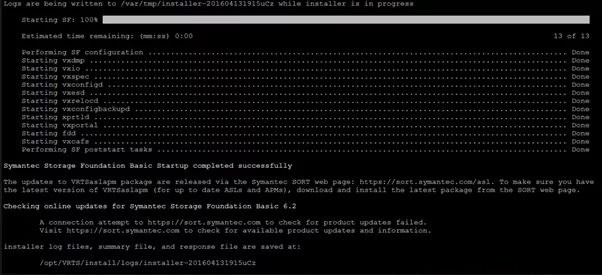 ge.
ge.
Create Volumes and File Systems on RHEL7
1. Identify the correct Disks using Vxdisk – Ensure that the disk is detected, not mounted using the fdisk and df -h command. Then, execute the below command to list the available disk under Veritas Volume Manager.
If you see the status as “online invalid,” it indicates these disks are yet to be added into Veritas Volume Manager. Be careful; even the mounted disks will show as invalid under Veritas Volume Manager because VxVM does not initialize these disks.
NOTE: Sometimes, we may get device column output in “Enclosure based names,” for example.
So, change the naming conversion format to Operating System Based names to help us identify the correct disk.
2. Change the “Enclosure Based Names” to “Operating System Based Names”
To revert to “Enclosure Bases names” use the below command:
Once we have identified the correct disks, go ahead to initialize the disks using the vxdisk setup command.
For example, let’s take sbd and sdc disks.
Disk’s status, which shows as online, is initialized, and it belongs to VxVM.
3. Create a Disk group and add the new disks. Disks groups are similar to volume groups in LVM, so create a disk group called “testdg” and add the identified disks to the “testdg” disk group.
Check the disk group properties.
Let’s assume that we have a new disk “sdd,” which needs to be added to the existing disk group “testdg”. So, we will see how to add a new disk into the existing Disk group. Initialize and add the disk as shown below.
4. Create a volume on the Disk group: Let’s create a volume of 100MB within the disk group.
List the volume details using vxlist command.
Note: If you get an error when you use “vxlist” command as shown below:
Start the below script:
5. Create a File system on the volume.
Where /dev/vx/rdisk/testdg/vol1 is the Device file for volume vol1
6. Mount the file system using mount command
Verify the mounted file system using mount and df command.
Online Resizing:
To achieve this, we can use “vxassist” and “vxresize” commands to resize the volume size, which means increasing or reducing the size of the volume. There are two parameters that can be used along with “vxassist” command to find the space available in a Disk group to know how much it can be increased or extended.
- Maxsize – Use this option to find the size to which a new volume or existing volume can grow.
- Maxgrow – Use this option to find the size to which an existing volume can be grown.
1. How to find the total Disk group size in Veritas Volume Manager:
The above output shows that mytestdg Disk group is initiated with the disk “sdb” and the disk size is 0.91G, and Volume “testvol1” size is 0.48G.
2. How to find the maximum free size available in the Disk group to extend or increase.
Where mytestdg our Disk group name the above output shows that we have 441Mb of free volume size. This can be used to create a new volume or extend the existing volume.
3. How to find the maximum size of an existing volume
The current size of the volume is 0.48G. We had found the size in the 1st point itself so that the volume can be increased to 941Mb.
4. How to increase the volume size or extend the volume size in Veritas Volume Manager
Option 1: To extend or increase the volume to a specific size 500Mb, use the grown option, so your total volume size would be 500Mb.
Option2: To extend or increase the volume by a specific size 800Mb, use the grown option, so your total volume size would be added with a specified size.
Resize the mounted volume size on the fly without unmounting.
5. How to decrease the volume size or reduce the volume size.
Option 1: To reduce or decrease the volume to a specific size 500Mb, use the shrink to option. So your total volume size would be 500Mb.
Option 2: To reduce or decrease the volumes by a specific size 800Mb, use the shrink option, so your total volume size will reduce the specified size from the total volume size.
In order to resize the mounted volume size on the fly without unmounting, use the image below:
Key Points:
- It is available for Windows, AIX, Solaris, Linux, and HP-UX. A modified version is bundled with HP-UX as its built-in volume manager.
- The latest version is Veritas Volume Manager 7.4.1Release date (Windows): February 2019.
- VXVM supports a cluster file system with CFS and Oracle RAC
- Base VXVM allows you to mirror your boot disk without any additional license and only the root dg.
- VxVM allows you to stripe and mirror and convert between layered and non-layered, preserving the data.
Disadvantage:
- VxVM main disadvantage is that it costs.
- We must pay additional licenses for every little feature.
Veritas Volume Manager provides manageability, availability, and performance enhancements for enterprise computing environments. It has benefits like Disk spanning, Load balancing, Complex multidisk configurations, Online administration, and High availability. I hope that this blog has been helpful!




